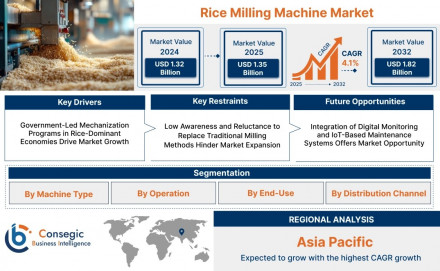Rice Milling Machine Market Competitive Landscape (2025-2032)

Rice Milling Machine Market Size:
Rice Milling Machine Market size is estimated to reach over USD 1.82 Billion by 2032 from a value of USD 1.32 Billion in 2024 and is projected to grow by USD 1.35 Billion in 2025, growing at a CAGR of 4.1% from 2025 to 2032.
Rice Milling Machine Market Overview:
The rice milling machine market is witnessing steady growth, driven by increasing rice production, urbanization, and consumer demand for better quality milled rice. The market encompasses a range of machinery, from traditional single-pass machines to modern multi-stage milling systems. Technological advancement, especially in automation and digital monitoring, is transforming how rice is processed, improving yield quality, reducing grain breakage, and enhancing profitability for millers. Moreover, governments are supporting agricultural mechanization to improve food security, further stimulating market growth.
Rice Milling Machine Market Includes Drivers, Restraints & Opportunities
Drivers:
- Rising Global Demand for Rice: As a staple food for more than half the world's population, the consistent demand for rice ensures sustained need for efficient milling equipment.
- Technological Advancements: Automation, digital controls, and energy-efficient designs are enhancing machine performance and attracting investment.
- Government Support for Agricultural Modernization: Many governments, especially in Asia and Africa, are promoting mechanization to improve productivity, leading to increased adoption of rice milling machines.
- Focus on Reducing Post-Harvest Losses: Efficient milling reduces grain breakage and improves yields, appealing to both commercial processors and farmers.
- Growth of Food Processing Industries: As rice finds applications in new processed food products, the demand for high-quality milling rises.
Restraints:
- High Initial Investment Cost: The capital required for purchasing and maintaining advanced milling machinery can be a barrier for small and medium-sized enterprises (SMEs).
- Lack of Skilled Labor: Operating advanced milling systems requires trained personnel, which may be scarce in rural areas.
- Dependence on Seasonal Harvests: As rice is a seasonal crop, machine utilization is not consistent year-round, affecting profitability.
- Limited Access to Finance: Farmers and small processors in developing regions often struggle to access credit for machinery investment.
- Environmental Concerns: Energy consumption and waste generation from large-scale milling operations can be environmentally impactful if not managed properly
Opportunities:
- Expansion into Emerging Markets: Countries in Sub-Saharan Africa and Southeast Asia are increasingly investing in rice processing infrastructure.
- Development of Compact and Affordable Machines: Manufacturers focusing on low-cost, efficient models can cater to small-scale farmers.
- Smart Rice Milling Solutions: IoT-enabled systems can optimize milling processes, reduce downtime, and provide data analytics for better decision-making.
- Public-Private Partnerships: Collaborations between governments, NGOs, and private companies can improve machinery access in underserved regions.
- Sustainability and Green Technologies: Innovations in energy-efficient and low-emission milling machines offer an edge in environmentally conscious markets.
Rice Milling Machine Market Competitive Landscape Analysis (Key Players)
- Bühler Group (Switzerland)
- Mill Master Machinery Pvt. Ltd. (India)
- Yamamoto Co., Ltd. (Japan)
- AG Growth International (AGI) (Canada)
- Fowler Westrup (India)
- Hubei Bishan Machinery Co., Ltd. (China)
- Hubei Fotma Machinery Co., Ltd. (China)
- Zhejiang QiLi Machinery Co., Ltd. (China)
Rice Milling Machine Market Industry Segmentation:
By Machine Type
- Rice Whitening Machine
- Paddy Separator
- Rice Husker
- Destoner Machine
- Others
By Operation
- Automatic
- Semi-Automatic
- Manual
By End-Use
- Commercial Milling
- Industrial Milling
- Community/Cooperative Milling
By Distribution Channel
- Direct Sales
- Distributors & Dealers
- Online Retail
By Region
- Asia-Pacific
- Europe
- North America
- Latin America
- Middle East & Africa
Regional Analysis of the Rice Milling Machine Market:
- Asia-Pacific: Dominates the market with countries like China, India, and Vietnam leading both in rice production and consumption. Rapid industrialization and government subsidies have spurred machinery adoption.
- North America: Limited market size but increasing demand for specialized rice products is driving interest in advanced milling systems.
- Europe: A niche market with a focus on imported rice processing; strict food safety regulations create demand for high-quality machinery.
- Middle East & Africa: Emerging market due to increasing rice consumption and agricultural modernization initiatives, especially in Nigeria, Egypt, and East African nations.
- Latin America: Brazil and other rice-producing countries are witnessing a gradual shift toward modern rice milling technologies.
Rice Milling Machine Market Recent Developments:
- Technological Innovations: Companies are introducing AI-powered and IoT-integrated rice milling systems for enhanced productivity and minimal human intervention.
- Strategic Partnerships: Collaborations between global equipment manufacturers and local distributors are expanding the reach of advanced machines in emerging markets.
- Sustainability Initiatives: Some players are launching eco-friendly rice mills with lower carbon footprints, targeting green-conscious customers and meeting regulatory demands.
- After-Sales Services Expansion: Firms are improving service networks and offering maintenance contracts, ensuring better machine uptime and customer satisfaction.
- Investments in R&D: Increased focus on research and development is leading to machines with higher yield efficiency, lower noise levels, and improved durability.
Contact us:
Consegic Business intelligence Pvt Ltd.
Contact no: (US) (505) 715-4344
Email: sales@consegicbusinessintelligence.com

